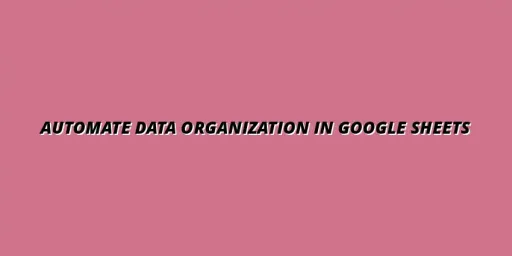Manage Data in Google Sheets
By Aria Kwan / Jan 30
Data validation is a crucial feature in Google Sheets that helps ensure the accuracy and integrity of the data entered into your spreadsheets. It allows users to set specific rules and restrictions on what can be inputted into cells. By using data validation, you can minimize errors and streamline data entry, making your spreadsheets more reliable and user-friendly.
In simple terms, data validation acts as a gatekeeper. It checks the data entered against predefined criteria and tells you if what you entered is acceptable. By understanding and applying data validation, you can enhance your productivity and maintain the quality of your data. This is especially important when streamlining data entry with Google Sheets for efficiency.
Data validation is a feature that allows you to control the type of data or the values that users can enter into a cell. This is especially important in collaborative environments where multiple users might be entering data. Implementing data validation rules ensures that only valid data is entered, which helps in maintaining consistency and accuracy.
The importance of data validation cannot be overstated. It prevents mistakes, saves time on data cleaning, and ensures that your analysis is based on reliable inputs. For example, if you have a list of dates, setting a validation rule ensures that only valid dates are accepted, reducing the chances of errors in your calculations. Learning to clean data in Google Sheets is a valuable skill.
In Google Sheets, data validation allows you to create rules for a cell or a range of cells. These rules can restrict entries to specific types, such as numbers, dates, or text, and can even include lists of permitted values. Users will see an error message if they try to enter data that doesn’t comply with these rules. For a deeper dive into the capabilities, check out this guide on essential Google Sheets data validation.
Here are some common types of data validation rules you can set in Google Sheets:
Implementing data validation comes with several benefits that can greatly enhance your spreadsheet experience. One key advantage is the prevention of errors during data entry, which can save you lots of time spent on correcting mistakes later on. Additionally, it empowers users by providing clear guidelines on what data is acceptable.
Other notable benefits include:
Now that you understand the basics of data validation, let’s dive into how to get started with it in Google Sheets. The process is quite simple and can be done in just a few clicks. You’ll learn where to find the data validation settings and how to navigate the menu for effective use.
Once you start using data validation, you'll quickly see the positive impact it can have on maintaining a high standard of data quality. Let’s jump into the steps to access data validation settings!
Accessing data validation settings in Google Sheets is straightforward. Just follow these steps to get to the right place:
After navigating to the data validation menu, you'll uncover powerful tools to help you create rules that control data entry effectively. This is where the magic happens!
Finding the data validation options is easy once you know where to look. Here’s a quick guide to follow:
In this new window, you can customize your data validation settings, including error messages and help tips for users. This setup is your gateway to ensuring only the right types of data are entered! For advanced techniques, consider using data validation with Google Apps Script.
The data validation menu in Google Sheets has a user-friendly layout that simplifies the process of creating rules. You'll find options for allowing certain types of data, creating lists, and more.
Here’s what you typically see in the data validation menu:
Having a clear understanding of this layout will help you navigate and utilize data validation effectively! Effective data management also involves using effective data management with filters.
Creating basic data validation rules is the next step after accessing the settings. We’ll cover how to set up drop-down lists and utilize restrictions for numbers and text. These foundations will enhance your data entry process!
Once you master these basics, you'll find it much easier to manage the data in your spreadsheets more efficiently. Let’s get started!
Drop-down lists are one of the simplest and most effective ways to control data entry. To set up a drop-down list in Google Sheets, follow these steps:
Now, users can simply click to choose from the options you’ve provided, making data entry faster and error-free!
Another important aspect of data validation is controlling the type of input allowed. You can set rules that only permit numbers or text entries within specified parameters. To do this:
This way, you make sure users are only entering the information you want, further maintaining your spreadsheet's integrity!
Once you're comfortable with the basics, you can explore advanced data validation techniques. These methods involve using custom formulas and ranges to create more dynamic validation rules. This flexibility can provide even greater control over your data!
Let’s jump into how you can implement these advanced techniques for effective data validation!
Custom formulas allow you to set sophisticated validation rules tailored to your specific needs. To use a custom formula:
Custom formulas can help you enforce unique requirements, like ensuring a cell can only accept a value if another cell meets a certain criteria!
Using ranges can make your data validation much more dynamic. Instead of hardcoding values, you can create a list from a range of cells. Here's how to do it:
This method allows you to update your list items easily by just changing the values in the specified range!
With a solid grasp of data validation, let’s explore some common scenarios. These examples will help you understand how to implement data validation effectively in real-world situations.
By anticipating these scenarios, you can tailor your data validation strategies to meet specific needs!
One common use of data validation is controlling date inputs. You can set rules to ensure users only enter valid dates, such as:
These validations help keep your date-related data accurate and well-organized!
Another useful scenario is ensuring that entries in a column are unique. This can be essential for things like employee IDs or product codes. To set this up:
This way, you can prevent duplicate values and keep your data clean!
As you explore data validation, you might have questions or encounter issues. Let’s address some frequently asked questions to help clear things up!
By understanding these common queries, you’ll feel more confident in using data validation effectively!
When users enter data that violates the validation rules, Google Sheets will display an error message. This message can be customized to provide guidance on what is wrong. You can choose to either reject the input or allow the entry but still show a warning.
Knowing how to manage these situations can help keep your data accurate and prevent frustration among users!
If you want to allow certain users to override data validation rules, you can do so by adjusting the settings. For instance, you can add an option to allow users to ignore the validation for specific cells. This is especially handy in collaborative environments where flexibility is needed.
Overall, data validation in Google Sheets is a powerful tool that can greatly enhance your data management skills!
Once you've set up data validation in Google Sheets, it’s important to keep things running smoothly. This means regularly updating and modifying your validation rules to fit your evolving needs. Whether you need to change existing rules or remove them entirely, knowing how to manage these settings is crucial for maintaining clean and accurate data in your spreadsheets.
Another key aspect is being aware of best practices for effectively managing data validation. This can help you avoid common pitfalls and ensure that your validation processes are efficient and reliable. Let's dive into how to make adjustments to your data validation settings!
Editing or removing data validation settings is straightforward. Here’s how you can do it in just a few steps:
By following these steps, you can easily update your data validation settings to meet your specific requirements. Always keep an eye on any changes in your data input needs, as they might require adjustments in your validation rules too!
Implementing best practices can help you maintain effective data validation. Here’s a list of tips to help you manage your rules:
By following these best practices, you can ensure that your data validation remains relevant and effective, keeping your spreadsheets neat and organized!
Sometimes, data validation can lead to conflicts or errors. Being aware of these common issues can help you troubleshoot effectively. Let's look at a few of the most frequent problems and their solutions!
Conflicts may arise when multiple validation rules apply to the same cells. To resolve these issues, consider the following steps:
By resolving conflicts promptly, you can ensure that your data validation works correctly without unnecessary interruptions!
When data validation errors occur, it can be frustrating. Here are some tips to help you fix these issues:
By implementing these tips, you’ll be better prepared to address data validation errors and maintain the integrity of your spreadsheets.
Utilizing data validation effectively can significantly enhance your productivity in Google Sheets. Integrating it with other features can create a smoother workflow and save you time. Let’s explore how you can maximize the efficiency of your spreadsheets!

 Manage Data in Google Sheets
Understanding Real-Time Data Management in Google Sheets
In today's fast-paced business world, manag
Manage Data in Google Sheets
Understanding Real-Time Data Management in Google Sheets
In today's fast-paced business world, manag
 Organizing Data Templates in Google Sheets
Understanding the Importance of Organized Data Templates in Google Sheets
In today's fast-paced worl
Organizing Data Templates in Google Sheets
Understanding the Importance of Organized Data Templates in Google Sheets
In today's fast-paced worl
 Automate Data Organization in Google Sheets
Understanding the Importance of Data Organization in Google Sheets
In today's data-driven world, org
Automate Data Organization in Google Sheets
Understanding the Importance of Data Organization in Google Sheets
In today's data-driven world, org